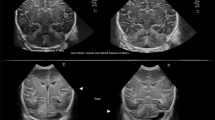Abstract
Background. We present several anatomic variants of the brain and artifacts related to scanning techniques which could be misinterpreted as lesions on neonatal cranial sonography.
Materials and methods. The findings were derived from US studies performed on 176 premature infants and 26 full-term newborns, using the anterior, posterior and mastoid fontanelles as acoustic windows.
Results. The pseudolesions are divided into three groups: ventricular system (asymmetric lateral ventricle size and coarctation of the lateral ventricles); choroid plexus ("split" choroid, "truncated" choroid and choroid cyst); and brain parenchyma (peritrigonal blush, thalamic pseudolesion, pseudo-absence of the inferior vermis, occipital pseudomass and calcar avis simulating intraventricular clot). We provide images of these pseudolesions and clues to their differentiation from true brain pathology. Images of several brain disorders are included for comparison. Knowledge of these potential pitfalls is essential for proper interpretation of US brain studies and will help to avoid the use of other more invasive diagnostic tests.
Conclusions. Misleading images seen on US examination of the neonatal brain that could be misinterpreted as pathology are presented, with clues to their differentiation from true lesions.
Similar content being viewed by others
Author information
Authors and Affiliations
Additional information
Electronic Publication
Rights and permissions
About this article
Cite this article
Enríquez, G., Correa, F., Lucaya, J. et al. Potential pitfalls in cranial sonography. Ped Radiol 33, 110–117 (2003). https://doi.org/10.1007/s00247-002-0836-y
Received:
Accepted:
Issue Date:
DOI: https://doi.org/10.1007/s00247-002-0836-y




